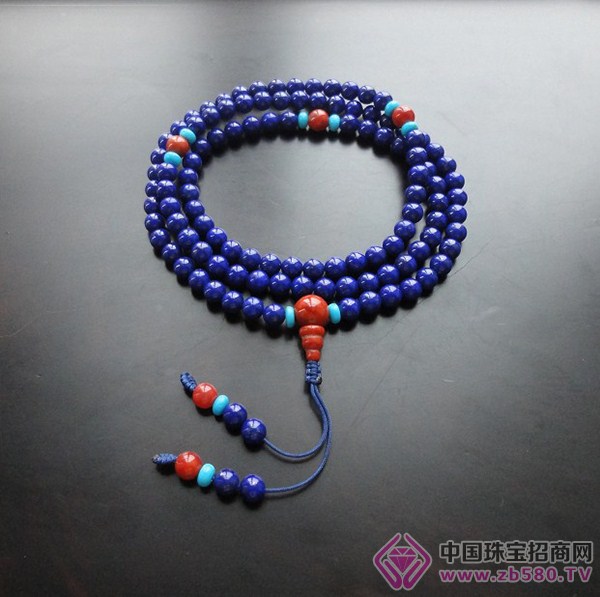
The lapis lazuli jade is composed of lapis lazuli minerals, often containing calcite, pyrite, and sometimes a small amount of diopside. The lapis lazuli jade produced in Afghanistan accounts for 25-40% of the lapis lazuli minerals. Jade is unique in blue, dark blue, light blue and ultramarine. Opaque, glass to grease luster. The hardness is 5.5 and the specific gravity is 2.7 to 2.9.
Dark blue and thick and not black, called "green gold"; dark blue and pyrite content is more than lapis lazuli minerals, called "Gold wave"; light blue and white calcite (generally no pyrite) It is called "promoting stone" (this name is derived from the ancient people using lapis lazuli as a stimulating drug).
In the ancient times, lapis lazuli was called “璆ç³â€ or “glazedâ€, and it was used to make the burial of the emperor. Because of its color, it can reach the road of ascension. "Recollections" volume five: "The First Emperor was the home, ... with the glazed treasure as the turtle." Some people think that the "glazed" here is the lapis lazuli.
However, the ancients discerned gems, and the colors were not qualitative, their colors were similar, and their quality was different, and their names remained the same. Therefore, whether there is lapis lazuli in the tomb of Emperor Qin Shihuang, archaeological workers are required to verify. Foreign scholar Herzo believes that China had lapis lazuli in the 2nd century (East Han), and Zhang Hongyi believed that China had three generations at the beginning of Shiya. This dispute has yet to be resolved by the majority of archaeologists.
The main production area of ​​lapis lazuli:
Qingjinshi jade is produced in contact with the mineral deposits. The main producing countries and product quality are as follows:
The output of Afghanistan is good in color, with a purple-blue color, less inclusions and high quality.
The Russian output is rich in color and color, and the inclusions are pyrite, and the quality is good.
Chilean produce has a green tone and contains calcite inclusions with low value.
In addition, Myanmar, the United States, etc. also produced, but the quality of the output was poor.
So far, China has not found the origin of lapis lazuli. Famous ancient places of origin in Persia and the Soviet Union. According to records, the lapis lazuli produced in Afghanistan and the Baikal region of the Soviet Union have all been imported into China. If we unearthed lapis lazuli in the tomb, and its jade source is not Afghanistan, it may be the product of Lake Baikal.
The identification of lapis lazuli generally starts from three aspects: color, texture and block. The identification of lapis lazuli includes both true and false identification, and the identification of quality is also one of its contents.
1. Color: The color of lapis lazuli is mainly blue, including sky blue, dark blue, azure, etc. The color is rich, uniform and pure, and can be made into jewelry. If white spots, white lines, etc. appear in the color of lapis lazuli, it will affect the purity of its color, and the visual effect will be insufficient. Therefore, the quality of such lapis lazuli will decrease.
2. Texture: The texture of lapis lazuli should be fine and dense, without flaws and cracks, and without impurities. And if there is pyrite, the pyrite is evenly distributed, forming a star-like point with good quality. If the pyrite is too concentrated, its quality will decrease. In addition, the more cracks, the lower the grade of lapis lazuli.
3. Block size: Under the same quality, the larger the lapis lazuli is, the more rare it is, and its more widely used, so the value is higher.
4. Body is the volume, which refers to the size of the lapis lazuli volume. Under the same quality conditions, the larger the volume of the lapis lazuli, the higher its value.
Lapis lazuli maintenance: Lapis lazuli is very strict with maintenance requirements, and it is easy to affect its texture with carelessness.
First of all, because lapis lazuli is a granular mineral aggregate, after its surface is contaminated, please do not rinse it with water. This is because the pollutants easily permeate the surface and pollute the quality of the interior. If you encounter such pollution, wipe it with a damp cloth. can.
Second, the lapis lazuli should be cleaned regularly (degaussing).
Finally, the hardness of lapis lazuli is not high, to avoid severe impact, and lapis lazuli taboo chemicals, also away from them.
Ladies Golf Shoes,Platform Tennis Shoes,Ladies Running Shoes,White Tennis Shoes Womens
Huaying Shoes Co. Ltd , https://www.sportshoe.nl